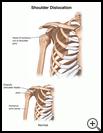
Shoulder Dislocation: Teen Version
________________________________________________________________________
KEY POINTS
- A shoulder dislocation means that the head of the upper arm bone moves out of the shoulder socket so that the shoulder joint no longer works properly.
- Your healthcare provider will put the bones back in the right position, and you will need to wear a splint or cast. Your provider may recommend stretching and strengthening exercises to help you heal.
________________________________________________________________________
What is a shoulder dislocation?
A shoulder dislocation means that the head of the upper arm bone moves out of the shoulder socket so that the shoulder joint no longer works properly. The dislocation can put pressure on the nerves and blood vessels in your shoulder and arm and damage them. When your shoulder is dislocated, you may also have broken bones.
The healing process may take 4 to 12 weeks, depending on your injury. With proper healing, you should regain full movement of your shoulder.
What is the cause?
A shoulder dislocation can be caused by a fall onto your hand or your shoulder, by twisting your upper arm, or if your arm is forced into an awkward position. It may also be caused by weak or loose ligaments that you were born with. Ligaments are strong bands of tissue that connect one bone to another. Other members of your family may have the same problem.
What are the symptoms?
Symptoms may include:
- Swelling
- Pain in your shoulder and upper arm that gets worse when you move
- Bruising
- A large bump under the skin in front or back of your shoulder
- A change in the shape of the shoulder that makes it look square instead of round
- Trouble moving your shoulder or not being able to move it at all
- Weakness or numbness in your shoulder or arm
How is it diagnosed?
Your healthcare provider will ask about your symptoms and medical history and examine you. You will have X-rays.
How is it treated?
A dislocated shoulder needs treatment right away to prevent permanent damage to the nerves and blood vessels.
Your healthcare provider will put the bones back in the right position. Before the procedure you will be given medicine to help you relax, but you may be awake during the procedure. You may be given medicine to keep you from feeling pain when this is done. Your healthcare provider will place your shoulder and arm in a type of sling called a shoulder immobilizer. It keeps your arm next to your body and stops you from moving your shoulder. You will wear the immobilizer for 2 to 3 weeks. You may start rehabilitation exercises during this time or after you are no longer wearing the immobilizer.
If your shoulder joint dislocates often, your healthcare provider may recommend surgery to tighten the ligaments that hold the joint together.
How can I take care of myself?
Follow the full course of treatment prescribed by your healthcare provider. In addition:
- Put an ice pack, gel pack, or package of frozen vegetables wrapped in a cloth on the injured area every 3 to 4 hours for up to 20 minutes at a time.
- Take nonprescription pain medicine, such as ibuprofen, or naproxen. Nonsteroidal anti-inflammatory medicines (NSAIDs), such as ibuprofen, naproxen, and aspirin, may cause stomach bleeding and other problems. These risks increase with age. Read the label and take as directed. Unless recommended by your healthcare provider, you should not take this medicine for more than 10 days.
- You will need to change or stop doing the activities that cause pain until the injury has healed.
- Do the exercises recommended by your healthcare provider.
Ask your provider:
- How long it will take to recover
- If there are activities you should avoid and when you can return to normal activities
- How to take care of yourself at home
- What symptoms or problems you should watch for and what to do if you have them
Make sure you know when you should come back for a checkup. Keep all appointments for provider visits or tests.
How can I help prevent a shoulder dislocation?
Many shoulder dislocations are caused by accidents that are not easy to prevent. Follow safety rules and use any protective equipment recommended for your work or sport. Warm-up exercises and stretching before activities and doing exercises to strengthen the muscles around your shoulder can help prevent dislocation.
Last modified: 2019-07-30
Last reviewed: 2018-04-16

